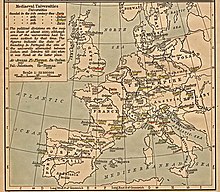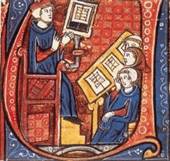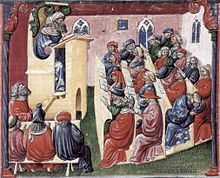Medieval University
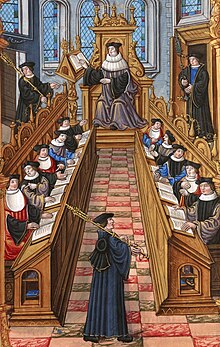
The medieval university is an institution of higher education that arose in the High Middle Ages and reached its full development in the late Middle Ages .
The first universities in medieval Europe were established in Italy , France and England in the late 11th and 12th centuries. Its aim was to impart knowledge in the fields of the seven liberal arts , law , medicine and theology . These universities developed out of the older school system. It's hard to tell when they became real universities, although the Studia Generalia list is a helpful starting point.
The word universitas was originally only applied to the scholastic guild within a course, i.e. to the community of students and masters. The term was originally always specified by adding a supplement, for example universitas magistrorum , universitas scholarium or universitas magistrorum et scholarium . In the late Middle Ages, the term universitas began to be used without such detailed definitions. It was understood exclusively as a self-governing community of teachers and scholars , whose body was recognized by the secular or spiritual authorities.
See the list of medieval universities for an overview of all foundations up to 1500.
history
Origins
The origins of the university in many parts of Europe lie in the Christian monastery schools and cathedral schools , where monks and nuns have been teaching since the 6th century AD . The university is considered a classically European creation that arose in medieval Western Europe.
“The university is one, yes, the European institution par excellence : As a community of teachers and students, endowed with special rights of self-administration, the definition and execution of curricula and research goals as well as the award of publicly recognized academic degrees , it is a creation of the European Middle Ages. ..No other European institution has achieved universal recognition in the whole world like the university with its traditional structures and scientific achievements. The titles of the medieval university, baccalaureate , licentiate , master's degree , doctorate , are recognized in the most diverse political and ideological systems. "
The first university to award educational degrees was the University of Bologna (founded in 1088).
Universities of the Middle Ages were also the ethos of Gothic influences: they had the goal of medieval communities (cities) or guilds build. With the increasing division of labor in the societies of the 12th and 13th centuries, there was also an increased need for clerics . Before the twelfth century, Europe's intellectual life had taken place in the monasteries , essentially concerned with the study of the liturgy and prayer. Few monasteries could produce real intellectuals. After the Gregorian reforms placed greater emphasis on canon law and the sacrament , bishops founded cathedral schools to train the clergy in canon law, but also in secular aspects of church administration, such as logic, rhetoric and bookkeeping, which preaching and the theological discussion, but also an effective financial management. Learning became a vital element in moving up the church hierarchy, and teachers also grew in prestige. However, the demand soon exceeded the capacities of the cathedral schools, which were essentially run by a teacher. In addition, tensions began to develop between the students of the Cathedral Schools and the citizens of smaller cities, leading to their relocation to larger cities such as Paris and Bologna .
The first universities in Europe ( Bologna University (1088), University of Paris (1160), Oxford University (1167), Cambridge University (1209), Palencia University (1212), Salamanca University (1218), Montpellier University (1220), University Padua (1222), University of Toulouse (1229) and the University of Orléans (1235) began as private ventures by teachers and their students. These sought privileges from those in power, and this practice spread. Emperor Friedrich I Barbarossa gave the first privileges to students in Bologna in Authentica Habita (1158). In a further step, Pope Alexander III forbade . 1179 the masters of the church schools to charge fees for the license to teach ( licentia docendi ) and to oblige them to issue this license to qualified teachers. "
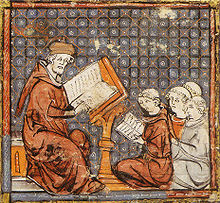
Establishment
The University of Paris is considered to be the forerunner of modern universities, especially under the influence of Petrus Abelardus , the author of Sic et Non ("Yes and No"), a book in which he collected texts for university studies. The Magisters designed the universitas according to the model of the medieval guild as a self-governing, permanent institution of higher education. The University of Paris became one of the first universities established when Pope Gregory IX. proclaimed the Bull Parens Scientiarium (1231).
The revolutionary step consisted in adding autonomy to the existing studium generale and universitas (the community of students and teachers) . “The papal bull of 1233, in which it was proclaimed that anyone who was allowed to work as a teacher in Toulouse could also teach elsewhere without further examinations ( ius ubique docendi ), made this privilege the most important characteristic of the university and made it a symbol its institutional autonomy ... By 1292 even the two oldest universities, Bologna and Paris, felt compelled to seek similar cops from Pope Nicholas IV . "
In the 13th century, half of the highest church offices ( abbots , archbishops , cardinals ) and over a third of the second highest offices were filled with magisters.
The development of the medieval university went hand in hand with the widespread introduction of the teachings of Aristotle ; the influence of Platonism or Neoplatonism declined in the late Middle Ages.
Characteristics
Medieval universities originally had no campus . Seminars took place where space was available, such as in churches or private homes. A university was not the physical place, but the community of individuals who had united as universitas . Soon, however, some universities (such as Cambridge University ) began to buy or rent space specifically for teaching.
Universities were divided into three types, depending on who paid the teachers. The first type was that of the University of Bologna , where students paid teachers. The second type is that of the University of Paris , where the teachers were financed by the Church. Oxford and Cambridge were largely paid for by the Crown and the State, which enabled them to survive the dissolution of the monasteries and the subsequent dissolution of all other Catholic institutions in England from 1538.
These structural differences gave rise to further characteristics. In Bologna, students determined the way things went - a fact that brought great pressure and disadvantage for teachers. In Paris, the school was run by teachers, which made it a magnet for teachers from all over Europe. In Paris, theology was also the main subject, so the control of the degrees awarded was in the hands of an external authority, the Chancellor of the diocese. In Bologna, where students chose secular subjects, law was the major.
You had to study for up to six years to get a bachelor's degree . Up to 12 more were necessary to obtain a master's or doctoral degree. The first six years were organized by the artist faculty . The seven liberal arts were taught here: arithmetic, geometry, astronomy, music theory, grammar, logic and rhetoric. The main focus was on logic.
After attaining the Baccalaureus Artium , the student could leave the university or pursue further studies in one of the following faculties: law , medicine or theology , and obtain a master's degree or doctorate . Theology had the greatest reputation and was the most difficult of these subjects. Originally, only a few universities had theological faculties because the popes wanted strict control over the study of theology. Until the middle of the 14th century, university theology studies were therefore only permitted in Paris, Oxford, Cambridge and Rome. It was only with the establishment of the University in Prague (1347) that its monopoly ended, and then other universities were given the right to set up theological faculties.
Courses were not organized according to topic, but according to book content. For example, a course could be about a book by Aristotle or a book from the Bible . Courses were also not eligible. The courses were available and every student had to attend the same courses. There was, however, the opportunity to choose the teacher in good time.
Students started studying at university around the age of 14 or 15. Classes usually started at 5:00 or 6:00 in the morning. Students were under the legal protection of the clergy, which meant they could not be subjected to physical harm. They only had to answer before a church court and were therefore immune to corporal punishment . This gave the student body the freedom to break laws with impunity in urban settings - a fact that provoked many abuses: theft, rape, and murder were not uncommon among students who faced no serious consequences. This led to tension with secular authorities as well as regular conflicts between students and citizens . The student body also sometimes went on "strikes" that left them for years. This happened in 1229 during the university strike in Paris, when several students died after a riot caused by students. The university went on strike and did not return until two years later.
After students had the legal status of monks, who were not allowed to be women under canon law, women were not admitted to the universities.
A popular textbook was that of the Sentences ( Libri Quattuor Sententiarum ) by Peter Lombard . Theology students and magisters were required to write extravagant comments on this text as part of their curriculum. Medieval ideas in philosophy and theology can be found in the scholastic commentaries, as scholasticism was a widely used teaching method.
Remarks
- ^ Riché, Pierre: Education and Culture in the Barbarian West: From the Sixth through the Eighth Century . University of South Carolina Press, Columbia 1978, ISBN 0-87249-376-8 , pp. 126-7, 282-98.
- ^ Verger, Jacques (1999): "Universität", Lexikon des Mittelalters , Vol. 8. JB Metzler, Stuttgart.
- ^ Rüegg, Walter (Ed.): History of the University in Europe . Vol. 1: Middle Ages . CH Beck, Munich 1993, ISBN 3-406-36952-9 , p. 13.
- ↑ a b c Kemal Gürüz: Quality Assurance in a Globalized Higher Education Environment: An Historical Perspective ( Memento of the original dated February 16, 2008 in the Internet Archive ) Info: The archive link was inserted automatically and has not yet been checked. Please check the original and archive link according to the instructions and then remove this notice. . Istanbul 2007, p. 5.
- ^ Walter Rüegg, Asa Briggs: History of the University in Europe. Vol. 1: Middle Ages . CH Beck, Munich 1993, ISBN 3-406-36952-9 , p. 68.
literature
- Alan B. Cobban: English University Life in the Middle Ages . Ohio State University Press, Columbus 1999, ISBN 0-8142-0826-6 .
- Stephen Ferruolo: The Origins of the University. The Schools of Paris and their Critics, 1100-1215 . Stanford University Press, Stanford 1998, ISBN 0-8047-1266-2 .
- Charles Homer Haskins : The Rise of Universities. Cornell University Press, Ithaca, New York 1972, ISBN 0-87968-379-1 .
- Jürgen Miethke : The medieval universities and the spoken word (= writings of the historical college . Lectures. Vol. 23). Munich 1990 ( digitized version ).
- Hastings Rashdall , FM Powicke and AB Emden : The Universities of Europe in the Middle Ages . 3 vols. Clarendon Press, Oxford 1987, ISBN 0-19-821431-6 .
- Robert S. Rait: Life in the Medieval University. Cambridge University Press, Cambridge 1931, ISBN 0-527-73650-3 .
- Robert Francis Seybolt (translator): The Manuale Scholarium. An Original Account of Life in the Mediaeval University. Harvard University Press, Cambridge 1921.
- Lynn Thorndike (Translator and Editor): University Records and Life in the Middle Ages . Columbia University Press, New York 1975, ISBN 0-393-09216-X .
